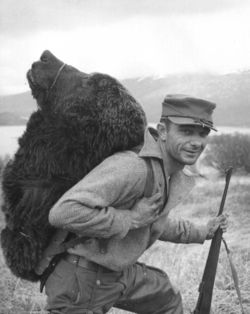Brown bear tracks have much deeper claw indentations than those made by black bear. [3]
Regional variations
The grizzly bear (Ursus arctos horribilis) is a North American subspecies. Grizzly bear are brown in color although not all brown bear inhabiting the interior of Alaska, British Columbia, Alberta, the Yukon, and Northwest Territories are grizzlies. Inland grizzlies tend to be much smaller than their coastal relatives. Grizzly bear seasons open in the spring or autumn depending on local regulations and jurisdictions. In most of the lower 48 US states, grizzlies are considered a threatened species under the Endangered Species Act. Grizzly bear are legally hunted in the Northwest Territories, Yukon, and Alaska. [4] The government of British Columbia banned the hunting of Grizzly Bears in 2017, as it did not align with their values. [5]
The Syrian brown bear (Ursus arctos syriacus) is a small and pale-furred bear subspecies found in Turkey, Syria, Iran, and the Caucasus mountains of Russia, Georgia and Azerbaijan. These bear are hunted mostly in the Caucasus, by stalking, where the harsh terrain offers a greater challenge to the hunter. [6]
The Eurasian brown bear (Ursus arctos arctos) is most widespread subspecies of brown bear in the Old World. It is mainly found today in Russia, Romania, Turkey and the former Yugoslavia, with smaller numbers being found in Norway, Sweden, Finland, the Czech Republic, Slovakia, Poland, Hungary, Albania, Bulgaria and Greece, and remnant populations are found in Spain, France and Italy. The non-endangered European population of Eurasian bear is hunted mostly in the north-western part of Russia, while the Asian population is hunted in the Ural Mountains and in eastern Siberia. Eurasian browns are usually hunted by baiting during the spring or autumn or by chance encounter while hunting other species. [6]
The Amur brown bear (Ursus arctos lasiotus) is smaller and darker than the Kamchatka brown bear, with a differently shaped skull and much larger teeth. Its range encompasses far eastern Russia, Northeastern Heilongjiang and Hokkaidō. It is usually hunted in the Khabarovsk and Primorsk regions by stalking. [6]
The Kamchatka brown bear (Ursus arctos beringianus) is a large subspecies found in far eastern Siberia. It is similar to the Kodiak bear, though darker in colour. These bear are usually hunted in the Shantar Islands (Okhotsk) and Magadan. In the spring, bear are hunted in coastal areas where they gather for food. During the autumn, bear are hunted while feeding on salmon or wild berries in the surrounding tundra. The average size of the bear taken is around 7.5–8.0 ft (2.3–2.4 m) in Magadan and Okhotsk and 8.0–8.5 ft (2.4–2.6 m) in Kamchatka. [6]
The Siberian brown bear (Ursus arctos collaris) is larger than the Eurasian brown bear, with denser bones and a slightly larger and heavier skull. Its fur is considered to be among the most luxuriant. It is smaller than the Kamchatka brown bear, though it is also said to be equal in aggression to an American grizzly. It lives east of the Yenisey River in most of Siberia (though absent in the habitats of the Kamchatka and Amur brown bear.) It is also found in northern Mongolia, far northern Xinjiang, and extreme eastern Kazakhstan. They are usually hunted in the Krasnoyarsk Region, Irkutsk Region and Yakutia in late August and early June. These hunts usually take place in rugged and heavily forested terrain, in the foothills of the mountains, or along the shorelines, where the forest is less dense. [6]
The American black bear (Ursus americanus) is the most common bear species native to North America. The largest black bear are usually taken beginning in late May and continuing on through most of June during the breeding season. Springtime is the preferred choice of black bear hunters, when their coats are at their thickest. Heavily timbered forests near agricultural lands often sustain large densities of black bear. They can also be found in proximity to cereal crops such as oats. [7]









